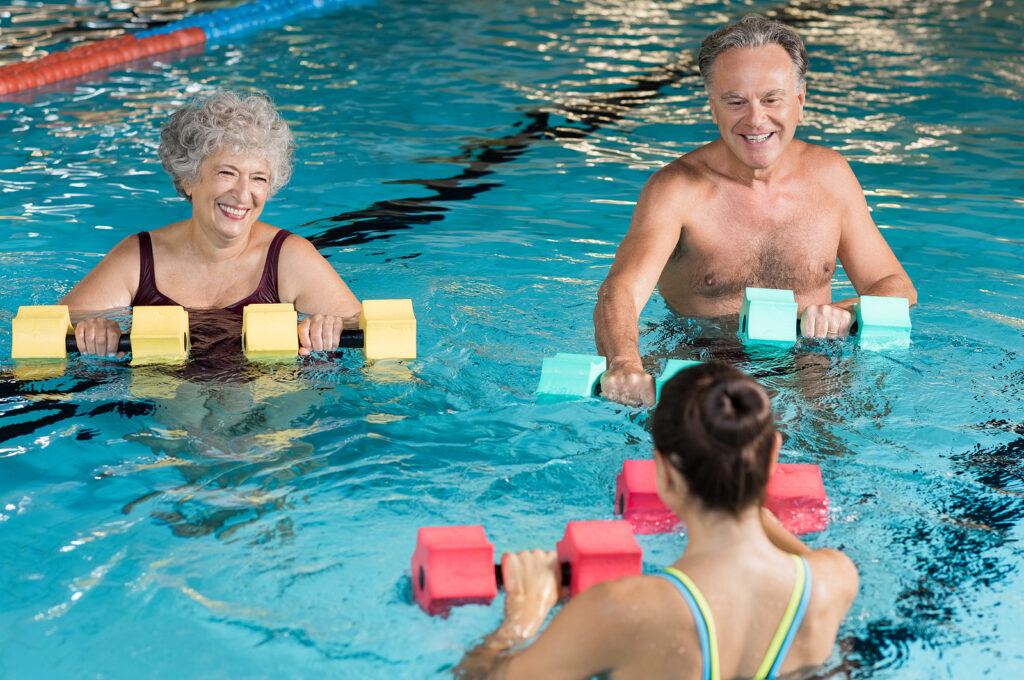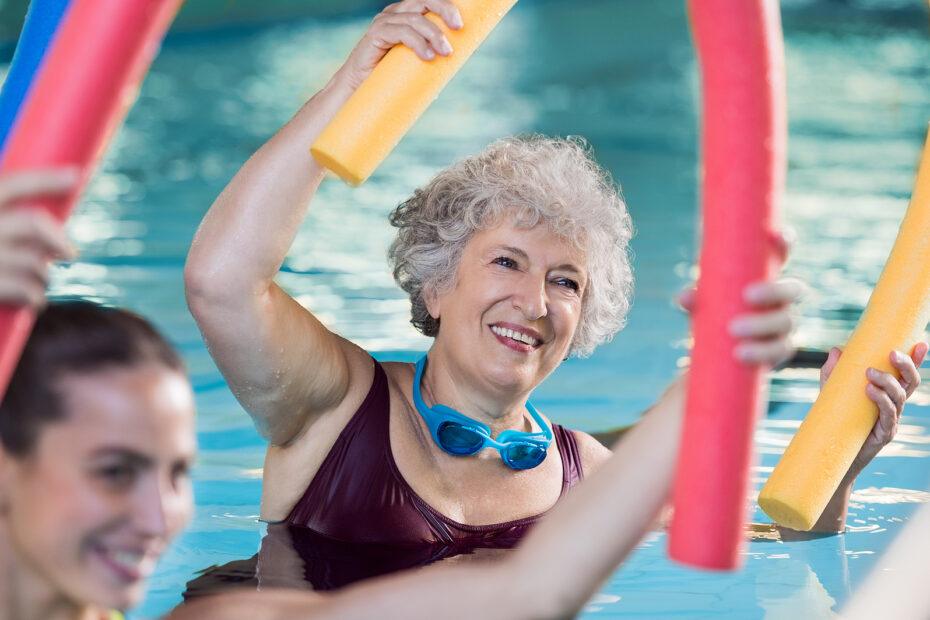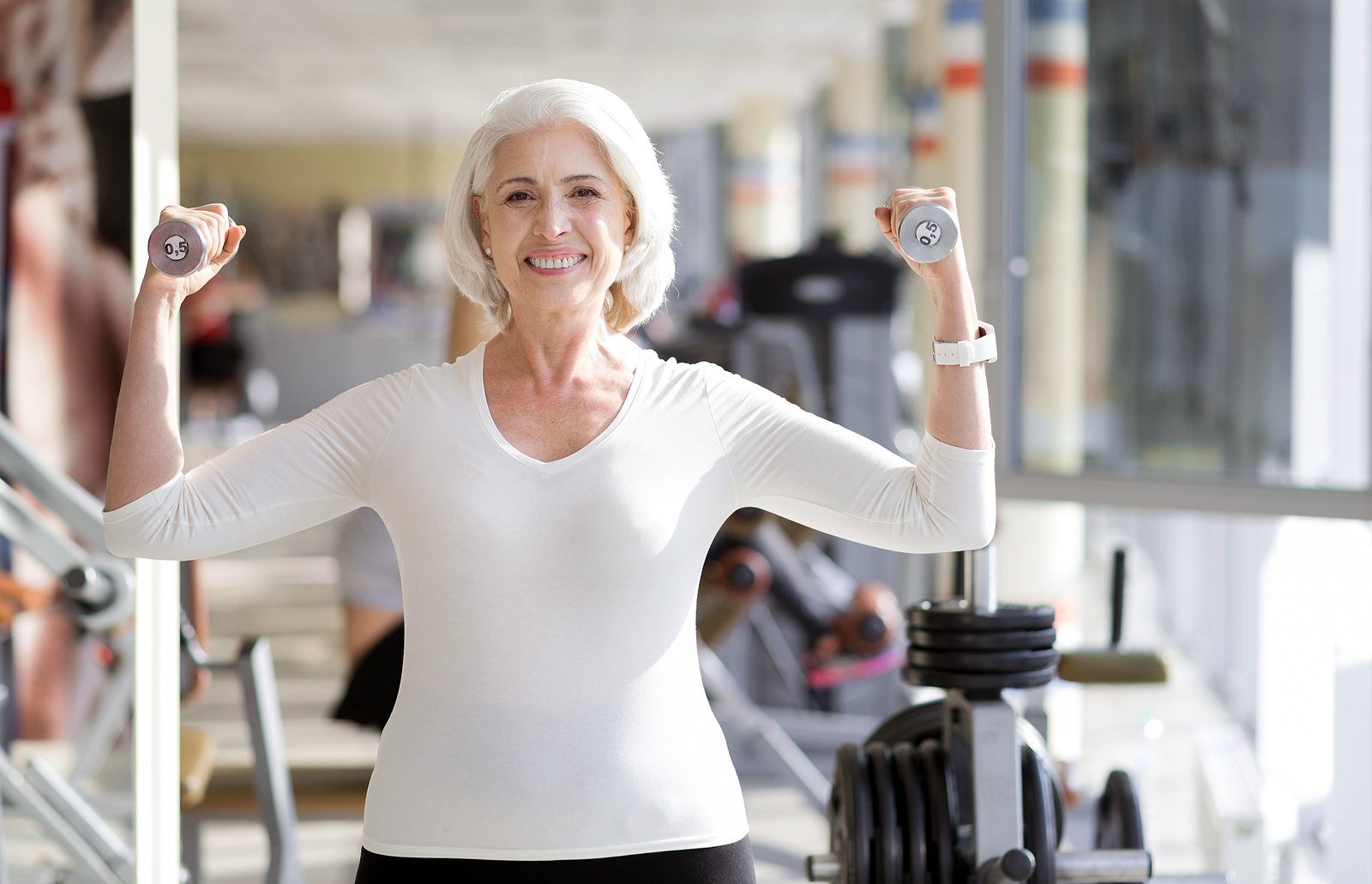Water-based exercises are an excellent way for seniors to stay active, improve mobility, and maintain overall health.
This is because the buoyancy of water reduces strain on joints and muscles, making movements smoother and less painful.
Pool exercises can also be used to reach various goals, including improving strength, balance, flexibility, and cardiovascular health.
All while providing a low-impact workout that minimizes the risk of injury.
The only real kicker is that you need access to a pool, which unfortunately, isn’t possible for all seniors.
In this guide, we’ll discuss some of the top pool exercises for seniors, but we’ll also go over the benefits these exercises offer and provide some safety tips as well.
Benefits of Pool Exercises for Seniors
Engaging in pool exercises offers numerous advantages, especially for seniors with mobility challenges or chronic pain:
- Reduced Impact on Joints: Water supports the body, reducing the stress on joints and making exercises more comfortable for those with arthritis or joint pain.
- Improved Balance and Coordination: The water’s resistance helps strengthen stabilizing muscles, enhancing balance and reducing the risk of falls.
- Enhanced Cardiovascular Health: Anyone familiar with swimming knows that moving in the water really gets the heart rate up. Regular pool workouts promote heart health, improve circulation, and boost endurance.
- Increased Muscle Strength: Moving against water resistance helps build muscle without the need for heavy weights.
- Relief from Pain and Stiffness: The soothing effect of warm water can ease muscle stiffness and reduce pain.
- Social Engagement: Participating in group classes can be a fun way to stay motivated and build community.
Safety Tips for Seniors
Before diving into a pool exercise routine though, seniors should keep these safety guidelines in mind:
- Consult with a Healthcare Provider: Ensure exercises are appropriate for your health condition.
- Use Non-Slip Footwear: Pool shoes can prevent slips on wet surfaces.
- Stay Hydrated: Even in water, it’s essential to drink fluids before and after exercising.
- Exercise with a Buddy: Having someone nearby adds a layer of safety and support.
- Know Your Limits: Start slowly and listen to your body to avoid overexertion.
- Use Safety Equipment: Pool noodles, kickboards, or flotation belts can offer added support.
9 Safe Pool Exercises for Seniors
1. Water Walking
- Instructions: Walk forward and backward across the pool in waist to chest-deep water. Swing your arms naturally and focus on taking steady steps.
- Benefits: Improves balance, coordination, and cardiovascular health.
Simply getting in a pool and walking can be a great exercise, especially for seniors who have difficulty walking on solid ground.
Try to walk with as normal a gait pattern as possible and try to build up to 30 minutes at a time.
2. Marching in Place
- Instructions: While standing in waist to chest-deep water, bring one knee up toward the ceiling and return it back to the floor. Repeat with the other leg. Continue alternating sides.
- Benefits: Improves hip strength, single limb stance time, and cardiovascular health.
Marching is a great pool exercise because the water reduce impact and makes it easier to keep your balance.
That said, feel free to hold on to an edge of the pool for even more stability if necessary.
Aim for 3 sets of 10 – 15 reps or 3 sets of 30 – 60 seconds.
3. Hip Abduction
- Instructions: While standing in waist to chest-deep water, keep your right knee straight and bring it out to the side as far as comfortably possible. Hold for a second and then return to the starting position. Repeat 10 – 15 reps and then switch to the left side.
- Benefits: Improves hip strength.
Standing hip abduction is an effective exercise on land too, but in the pool, the water acts as an additional form of resistance, making it a great way to help improve hip strength.

4. Arm Raises
- Instructions: Stand in waist-deep water with your arms at your sides. Slowly raise your arms to shoulder height, then lower them back down.
- Benefits: Strengthens shoulder and arm muscles while enhancing range of motion.
A simple exercise, but a great way to get your shoulders moving.
You can also experiment with performing this exercise in deeper water – the more of your torso you submerge, the more the water will assist with elevating your arms.
Just make sure you don’t get too deep for your comfort zone.
5. Water Push-ups
- Instructions: Stand facing the pool wall, place your hands on the edge, and push your body away, then slowly return.
- Benefits: Strengthens the chest, arms, and shoulders.
This is a fun variation on the classic land exercise and the water helps absorb a lot of the forces, making this a much lower impact exercise.
Aim for 3 sets of 10- 15 reps.
6. Flutter Kicks
- Instructions: Hold onto the pool edge or use a kickboard. Extend your legs behind you and kick gently.
- Benefits: Improves leg strength and cardiovascular endurance.
You need to be comfortable with assisted floating for this exercise, but if you are, it’s a great way to get your heart rate up.
Aim for sets of 30 – 60 seconds.
FYI, here’s a quick video illustrating the kicking pattern for this exercise in case you aren’t sure what your legs should be doing.
7. Pool Noodle Bicycle
- Instructions: Place a pool noodle under your arms or behind your back for support. Pedal your legs as if riding a bicycle.
- Benefits: Enhances core strength and lower extremity range of motion.
Noodle bicycling is a fun way to get pretty much everything from the waist down moving, making it a great low-impact exercise for your joints.
Shoot for 3 – 5 sets of 30 – 60 seconds.
8. Noodle Chest Press
- Instructions: Stand in waist – chest deep water, holding a pool noodle straight out in front of you. Pull the noodle in toward your chest and then push back out again (as if bench pressing in a standing position).
- Benefits: Improves chest, shoulder, and tricep strength.
This exercise is beneficial for shoulder range of motion and strengthening.
Speaking of strengthening, if you’re looking for a harder workout, you can use water dumbbells to add more resistance.
Shoot for 3 – 5 sets of 10 – 15 reps.
9. Pool Squats
- Instructions: Stand in waist – chest deep water, feet shoulder-width apart. Bend your knees as you stick your hips back, as if sitting in a chair. Hold for a second and then return to the starting position.
- Benefits: Improves leg strength.
Pool squats are performed essentially the same way as land squats, but with the added cushioning the water provides to make it a bit easier.
You lose a bit of the strengthening effect here because the water makes it easier to come back up, but it’s still a nice low-impact way to get your leg muscles (and joints) working.
Helpful tip – make sure the water isn’t too deep or you’ll submerge your head as you squat!
Useful Accessories for Pool Workouts
Using accessories can enhance the workout experience for seniors, providing extra support and making exercises more enjoyable.
Here’s a list of some of the most popular options:
Water Shoes: Prevent slipping and offer extra traction on pool floors, adding stability during exercises.
Pool Noodles: Great for balance support and flotation assistance. They can also be used for resistance exercises.
Kickboards: Help build leg strength while providing upper body support. Ideal for flutter kicks and leg workouts.
Flotation Belts: Offer buoyancy, making deep-water exercises more accessible and reducing strain on joints.
Water Weights: Lightweight when dry but create resistance underwater, adding challenge to arm exercises.
Aqua Gloves: Increase resistance with arm movements, helping to strengthen muscles and improve coordination.
FYI, Amazon has a good selection of affordable pool accessories to choose from.
Final Thoughts
Pool exercises are a safe and effective way for seniors to maintain mobility and strengthen muscles with reduced risk of falls/injury.
The water’s gentle support helps reduce impact, while also working as a built-in spotter.
That said, exercising in the pool comes with its own risks – so if you need help getting in/out of the pool or aren’t a particularly strong swimmer, make sure you have a spotter to assist.
The exercises listed here are pretty simple and offer good examples of what can be done safely in the pool, but feel free to use your imagination too.
Any movement you can comfortably do in the water is fair-game, especially if it gets your heart rate up.
Just remember, exercise shouldn’t hurt – if you feel pain during any exercise, please discontinue and consult your physician.
Anyway, I hope you found this guide helpful and if you have any questions or comments, just leave ’em below and I’ll get back to you shortly.



